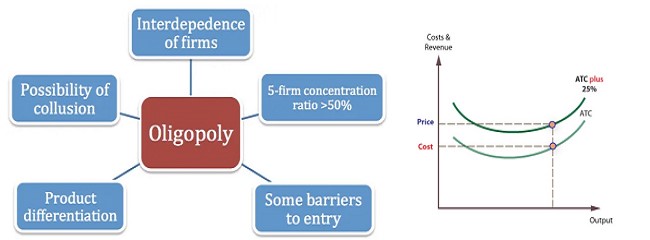Main Characteristics of Oligopoly in Economics
- What are the main characteristics of an oligopoly? Give real world examples.
- Why could the market for Automobile be said to be oligopolistic?
- Why do you think that firms choose not to compete on price?
- What are the main barriers to entry in the Automobile market?

Some example of Oligopoly:
Airbus and Boeing control are some of the examples where two companies control a big portion of a market. There comes some soft drink market which is controlled by Coca-Cola and Pepsi. Then there are some examples of commercial aircraft market.
Oligopoly market types:
Based on the characteristics of oligopoly, it can be divided into following types:
Perfect oligopoly:
It will be said to be a perfect oligopoly condition when two company offer homogenous products (Vives 2001). Well, such condition is very rare, but steel, aluminum, and chemical producing company can be treated as pure oligopoly industries (Onofri & Boatto, 2015).
Differentiated oligopoly:
It happens when the firms produce different products but are the close substitute for each other. The industries that can come under this condition are cigarettes manufacturing company, soft drinks production industries, and car manufacturing industry. Every company’s product will have their characteristics.
Conniving and non-conniving oligopoly:
It is also known as the cooperative oligopoly. Here the firms together decide the price of the product. On the other side when there is a stiff competition among the firms, that situation called the non-conniving oligopoly.
Characteristics of Oligopoly:
The Oligopoly characteristics are very special, and those are not there in market structure. However, followings are some main characteristics of the oligopoly.
- Interdependence
- Advertising and selling costs
- No-price competing in the market
- Block firms to enter the market
- Group behaviour
- Types of the products
- Uncertain demand curve
Automobile market as Oligopoly
After looking at the characteristics of oligopoly, where there are few companies in the market which offer homogenous products and dominating the majority of the market share, that situation is called as an oligopoly. The automobile market can be treated as the oligopoly market condition.
The automobile market justifies one important oligopoly characteristics, i.e., few automobile manufacturers are there who is now controlling the market. If compared with current automobile market scenario, it will be quite difficult for a new company to enter this market. Well-known automobile industries, like Ford, BMW, Volvo, and Mercedes-Benz have been achieved good economic scale across the world.
Barriers to entering the automobile market
A new company will able to survive in the market if the company provides that quality of vehicles like Mercedes-Benz. For this, they need strong capital. This factor can diversely affect them. Apart from that, the former companies will not let the new companies enter the market easily. Another major factor is the reputation and image of the new company.
For a reputable and well-known company, it will not difficult to enter the oligopoly market because they carry that much of brand reputation(Mazzeo 2002). But, for a new market, they may not have the brand reputation. So, the above-detailed discussion has given a clear idea on the characteristics of oligopoly and how oligopoly market can affect the new industry.
Unit: ECO101 – Microeconomics
The following question worth 25 marks, please answer all of them. If needed please use Harvard referencing style. There is no word limit, but it is necessary that you provide answers with explanations.
Nimbus, Inc., and Cleansweep, Inc., are the only producers of flying brooms. Each firm has two strategies: Spend 30,000 galleons a year on research and development (R&D) or spend nothing on R&D. If neither firm spends on R&D, Nimbus' economic profit is 80, 000 galleons and Cleansweep's economic profit is 40,000 galleons. If each firm conducts R&D, market shares are maintained, but each firm's profit is lower by the amount spent on R&D. If Nimbus conducts R&D and Cleansweep does not, Nimbus makes an economic profit of 120,000 galleons, while Cleansweep incurs an economic loss of 20,000 galleons. If Cleansweep conducts R&D and Nimbus does not, Cleansweep makes a profit of 60,000 galleons while Nimbus loses 10,000 galleons.
- Construct a payoff matrix for the game that Nimbus and Cleansweep must play. (4 marks)
- Find the Nash equilibrium. In the Nash equilibrium, what is each firm's equilibrium profit? (4 marks)
- What is the cooperative outcome? Would the firms make more economic profit if they collude to achieve the cooperative outcome? (4 marks)
- Describe the characteristics of an oligopoly. (3 marks)
- What market structures other than oligopoly have the characteristic of one firm's actions affecting the actions of its competitors? Explain your answer. (3 marks)
- "If firms in duopoly collude and operate as a monopoly, the industry produces more output compared to the Nash equilibrium.&quor; Is this statement true or false? Explain. (3 marks)
- g) What is a natural oligopoly? How does it arise? Give an example. (4 marks)


